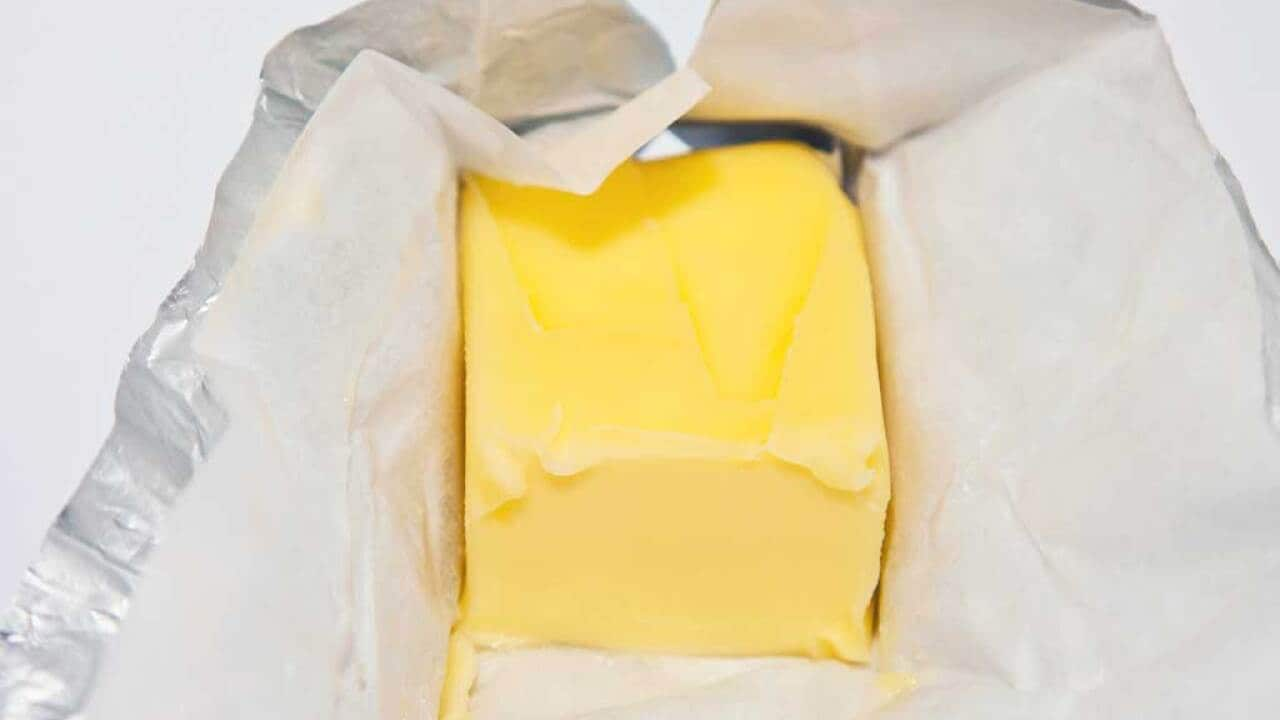If butter makes everything better, French butter takes things to another level. From Julia Child's well-documented preference for the French stuff to Lune’s Kate Reid who swears by Beurre d’Isigny for her croissants, French butter is the gold standard.
Rich, creamy, nutty; there’s nothing quite like it. But what is different about it? Here's the lowdown on the craft in the creation of French butter, which gives it a unique taste and texture.
A taste of terroir
The greatness of French butter starts with the cows, specific breeds like Normande and Froment du Léon, known for producing milk that is high in fat. But it’s not just the breed that matters, it’s also what they eat. “It's this holy trinity to make a great product: amazing soil, proper grass-fed cows, and then the type of cows,” explains cheesemonger Anthony Femia, owner of Melbourne’s , where the delicate (which holds AOC protection) and the rich, complex , is stocked.

Froment du Léon cow in France Credit: Rob Locke / @foodwinedine
Traditional methods dating back centuries
The French have made artisanal butter since the Middle Ages, passing down time-honoured techniques through generations. One of the key differences? .
Unlike standard butter, French butter is made from fermented cream, thanks to the addition of lactic acid bacteria, which enhances its flavour. Then, it’s churned slowly, a crucial step.
"You can never compete with the flavour of their unique butter because of the culturing, the 18-hour ferment, the slow-churning, and then, that clean, rich, nutty flavour that comes through," says Femia.
The prized Beurre de Baratte is churned gently, in small batches, sometimes still in wooden barrels. This process accentuates the tangy, complex characteristics of fermentation.
Once churned, French butter is kneaded (malaxé) to refine its texture.

Pierre Issa checking out French cream in Scaër, France. Credit: Rob Locke @foodwinedine
Why fat content matters
French butter must have at least 82 per cent butterfat, compared to 80 per cent in most commercially produced butters in Australia. A 2 per cent difference may seem small, but it’s a game-changer.
“It’s like interest rates; it's really valuable. And you can get a higher fat content when you use a baratte as opposed to a continuous churn. It adds to the creaminess and mouthfeel of the butter. If it's under 82 per cent, it can be a little flat and a little bit watery,” explains Pierre Issa, co-owner of Sydney’s .
While mass-produced Australian butter may sit at 80 per cent, many artisanal Australian butters, like Pepe Saya, also exceed 82 per cent.

Pierre Issa's favourite French butter at Ferme Goulpière Credit: Rob Locke @foodwinedine
A valued culture and history
“The history, the heritage that France has, with products like butter and cheese is unmatched. I’m not a Francophile by any means, but it’s a fact. You cannot rob them of that,” says Issa. “For example, if you have a herd of native cows to Brittany, the government will subsidise you to keep this herd going and keep this breed alive, to keep this tradition alive. It's absolutely fantastic.”
Jack Gaffney of , who spent two years in France studying dairy traditions, also points out that food culture plays a huge role.
“It is normal in ultra-capitalistic nations like the USA, UK and Australia to consume lunch on the run or while working at one’s desk. This is much rarer in France. Each meal is cared for, and each ingredient is considered – there is and always has been a market for quality produce and as such the standard is high, but the expectation is too,” he says.

Jack Gaffney in Brittany
“With these AOC butters, you’re tasting the terroir, you're tasting the method, and you're tasting high quality, says Femia.
Do artisanal Australian butters compare?
The Australian artisanal butter scene has boomed over the last decade. But how does it stack up compared to France?
“We can compare the two, but we should also know that they are difficult to compare,” says Gaffney. “French butter definitely has a certain cachet, but the credibility of Australian butter is gaining momentum thanks to the hard work of farmers and small conscientious producers. We are at the start of the journey and the future is extremely promising.”
Almost as a stamp of approval, Femia, who carefully curates the products that are stocked in his store, carries the Australian Madeleine Butter and Long Paddock Butter alongside premium French butters.
How to enjoy French butter
Taste it first
Femia suggests tasting unsalted butter first to appreciate its full flavour. He puts it on his table as a feature, almost like a cheese plate, eats it thickly spread on radishes or good bread.
“The ratio of bread to butter is no longer just a thin sliver of butter with a piece of bread. It's the exact same size of butter as bread,” he says.
Use it in cooking
Thanks to its higher fat content, French butter is perfect for baking, elevating everything from croissants to shortbread. It also works wonders in roasted vegetables and for steak or seafood.
Buy it fresh
If paying a premium for French butter, ensure it is air-freighted, not sea-freighted. “If it’s sea-freighted, the butter comes in frozen and gets defrosted for retail, which affects quality and shelf-life,” warns Femia.
Store it right
Keep butter wrapped or in an airtight container to prevent it from absorbing fridge odours, and avoid storing it in the fridge door, where temperature fluctuations can affect the texture. For soft, spreadable butter, use a butter bell or butter keeper.
Whether you’re slathering it on a baguette, folding it into pastry, or biting straight into it (no judgment here!), one thing’s for certain: when it comes to French butter, you really are consuming something very special.






